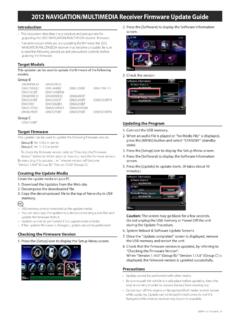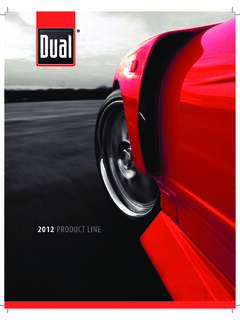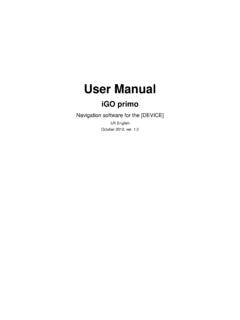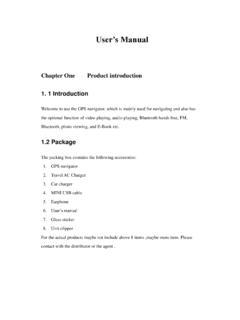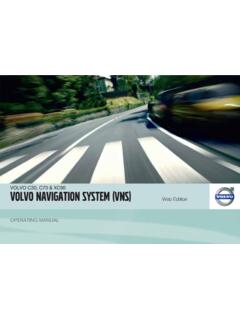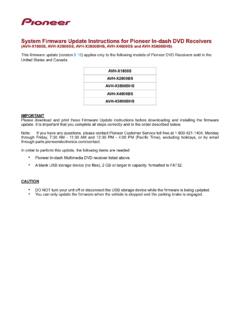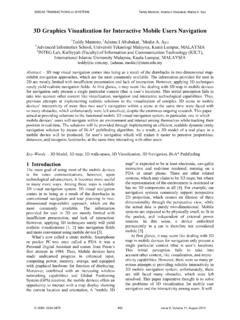Transcription of 3006 IEEE TRANSACTIONS ON WIRELESS …
1 3006 IEEE TRANSACTIONS ON WIRELESS COMMUNICATIONS, VOL. 11, NO. 8, AUGUST 2012 CodePlay: Live multimedia Streaming in VANETsUsing Symbol-Level Network CodingZhenyu Yang,Member, IEEE,Ming Li,Member, IEEE,and Wenjing Lou,Senior Member, IEEEA bstract The fundamental challenges of providing live mul-timedia streaming (LMS) services in vehicular ad hoc net-works (VANETs) come from achieving stable and high streamingrate (smooth playback) for all the interested vehicles whileusing minimal bandwidth resources, especially under the highlydynamic topology of VANETs and the lossy nature of vehicularwireless communications. Packet level network coding (PLNC)technique has been widely accepted as an effective approachto improve the network performance during the last recentsymbol-level network coding(SLNC) could furtherimprove the efficiency of bandwidth utilization by exploitingboth WIRELESS symbol-level diversity and the benefits of networkcoding.
2 In this paper, we introduce CodePlay, a new LMS schemein VANETs that fully takes advantage of SLNC through acoordinated local push mechanism. Streaming contents are ac-tively disseminated from dedicated sources to interested vehiclesvia local coordination of distributively selected relays, each ofwhich will ensure smooth playback for vehicles nearby. Extensivesimulations show that simply replacing the SLNC with PLNC technique in previous LMS schemes can not provide satisfiableuser experience, and special scheme design based on the uniquecharacteristics of SLNC proposed in CodePlay is necessary forfuture LMS applications in Terms Vehicular networks, symbol-level network cod-ing, live multimedia INTRODUCTIONLIve multimedia streaming (LMS) is promising in vehic-ular communications due to its more precise, compre-hensive and user friendly merits compared with plain textbased services.
3 Typical scenarios for LMS applications couldbe illustrated as the following example. A roadside accesspoint (AP) continuously broadcasts the streaming video of thecurrent road traffic conditions to vehicles driving towards it forintelligent navigation , which is especially useful in inclementweathers. In order to provide the described services, we canutilize APs to disseminate the streaming content to vehiclespassing by. However, due to the relatively high deploymentcost of roadside APs and eachAP s limited communicationrange, the entire road can not be fully covered merely byAPs. Therefore, the vehicles have to form a vehicular ad hocnetwork (VANET) and cooperatively propagate the streamingcontent when they are out of coverage of speaking, there are three primary requirementsfor LMS services in VANETs.
4 Firstly, considering the largevolume of each LMS content, all the receivers should achieveManuscript received January 9, 2012; revised March 13, 2012; acceptedApril 17, 2012. The associate editor coordinating the review of this paperand approving it for publication was N. Yang is with , WA 98102 (e-mail: Li is with the Department of Computer Science, Utah State University(e-mail: Lou is with the Department of Computer Science, Virginia Tech (e-mail:and Object Identifier and high streaming rate for smooth playback. Note thatthe rate only needs to reach the requirements of related mul-timedia standards and higher rate is not necessary. Secondly,the service delivery delay should be short for all the receivers,and the delay variation should be small for neighboringreceivers for possible coordinated actions between them, forexample, bypassing a blocked road.)))
5 Thirdly, LMS servicesshould consume minimal amount of bandwidth resource forbetter coexistence with other competing services, since thebandwidth is a precious resource in VANETs. Essentially, thiscorresponds to improving bandwidth requirements are conflicting with each other and arevery challenging to be achieved simultaneously. In order toensure smooth playback of LMS content, we have to combatwith the lossy vehicular WIRELESS links and highly mobile anddynamic topology of the underlying VANETs. In vehicularcommunications, packet loss is a frequent phenomenon dueto channel fading. To ensure stable streaming reception withinshort time delay, a large number of (re)transmissions would beincurred, which severely decreases the bandwidth addition, smooth playback requires vehicles to make localoptimal transmission decisions, such as which vehicle shouldtransmit what content to which neighbors.
6 This means vehiclesneed to learn precise and in-time neighbor information (suchas reception status). However, under VANETs with ever-changing topology, this learning process may lead to highcommunication overhead. Thirdly, VANETs tend to experi-ence frequent partitions [1], which increases the difficultyof determining the best relay nodes and proper transmissionopportunities for them. This mayresult in major performancedegradation without careful protocol this paper1, we try to exploit symbol-level networkcoding (SLNC) [3] for designing a distributed live multimediastreaming scheme in VANETs. Compared with traditionalpacket-level network coding (PLNC), SLNC performs net-work coding on smaller symbols, which refers to a group ofconsecutive bits within a packet.
7 SLNC not only enjoys thebenefits of NC, but also gains from exploiting the symbol-leveldiversity in WIRELESS transmissions [4]. By recovering correctlyreceived symbols from erroneous packets, SLNC mitigates theimpact of lossy links and packet collisions, improves the utilityof each transmission and in turn reduces the total numberof transmissions. However, how to provide satisfiable LMSservices in VANETs with minimal bandwidth is not a trivialproblem even with the help of SLNC. To this end, we makethe following main contributions. We proposed CodePlay to fully exploit the benefits ofSLNC in VANETs, the core of which is a coordi-nated local push mechanism. In order to disseminate1 The preliminary version of this paper appeared in [2].1536-1276/12$ 2012 IEEEYANGet al.
8 : CODEPLAY: LIVE multimedia STREAMING IN VANETS USING SYMBOL-LEVEL NETWORK CODING3007the streaming content from sources to all the receiverstimely and smoothly, a group of spatially separated relaysare selected distributively, whose transmissions can bringmost useful information to vehicles nearby. Each relayactively pushes coded information to cover its neighbor-hood. By taking advantage of SLNC s better tolerance fortransmission interference, the concurrent transmissions ofall relays could be optimally coordinated locally, whichcould provide continuous streaming coverage for thewhole VANET efficiently. To enable CodePlay to perform well under variousVANET densities, we also proposed an opportunis-tic transmission scheduling algorithm based on well-designed carrier sensing mechanism, where the network sspatial reusability can be adaptively enhanced with neg-ligible overheads.
9 We implemented CodePlay in NS-2 and carried out ex-tensive simulations to evaluate its performance by variouspractical metrics. We showed both the potential andthe constraints of providing LMS services in with traditional PLNC technique, the adoptionof SLNC can provide more and better design choicesfor VANET designers. Also the particular topologicalcharacteristic of VANETs [1] (the vehicles running onthe highway tend to form disjoint clusters rather thanuniformly distributed) needs to be specifically consideredinto the scheme design. As far as we know, CodePlaymade the first step towards this RELATEDWORKA. NC-based streaming schemesStreaming services are widelydeployedontheInternetnowadays, such as PPLive, PPStream, etc. In particular, net-work coding (NC) [5], by allowing nodes to combine differentpackets received previously together to generate coded packetsfor transmitting, has been shown to be an effective techniquethat can improve the user experience of video streamingservice for large scale systems.
10 For example, [6], a random push-based P2P scheme usingnetwork , deployed a NC-based on-demand streaming scheme in a large-scaled commercial sys-tem [7], which showed the benefits of NC for multimediastreaming in a real P2P network. In WIRELESS mesh networks, proposed a video-aware opportunistic networkcoding scheme across different flows [8] and a reliable NC-based streaming broadcasting schemethat focuses on reducing transmission overheads [9]. However,all these schemes are for traditional wired or WIRELESS networksand are not suitable for VANETs, due to VANETs uniquecharacteristics described Streaming schemes for out a series of experiments using twovehicles under different scenarios, which proved the possibilityof video streaming between moving vehicles [10].

